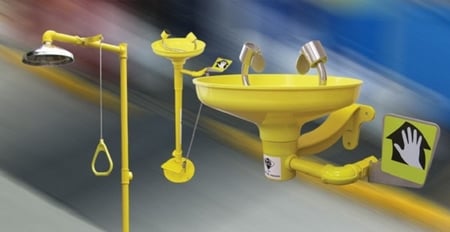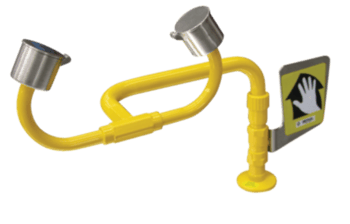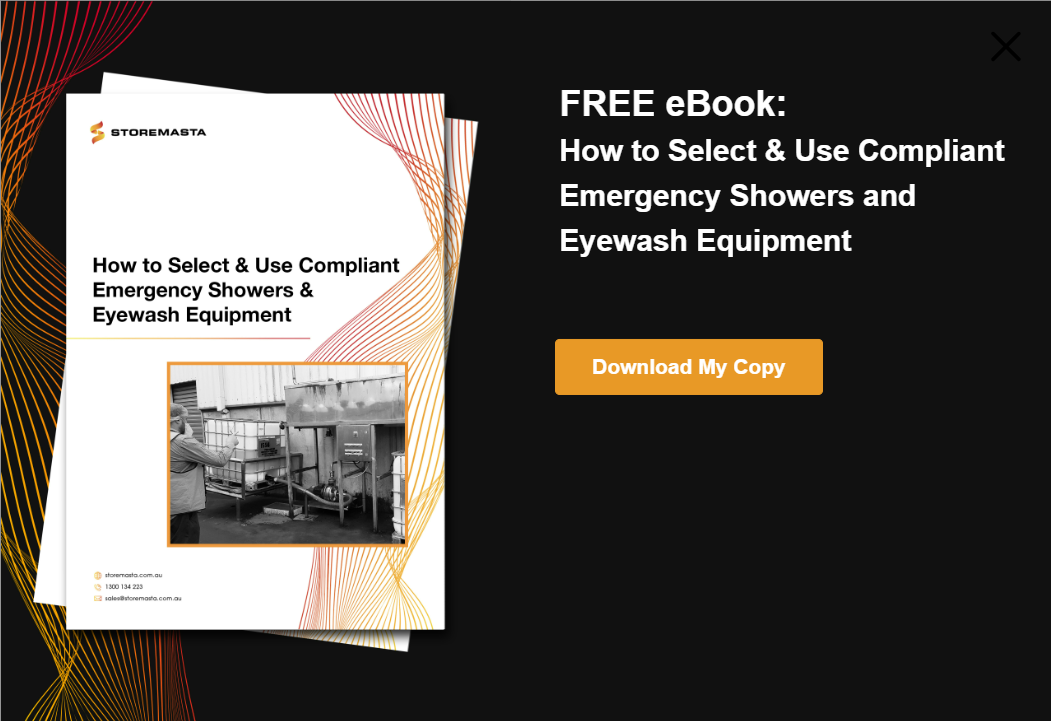Purchasing and installing any emergency equipment is only one step in the safety process. You also need to develop clear and practical operating procedures, so your staff understand how to properly use and maintain the safety shower and eyewash station. These policies should be developed inline with the requirements of the Australian Standard AS4775 and maufacturers’ instructions, so your staff can carry out procedures in full compliance.
But where do you start? This post will provide a step-by-step guide on developing operating procedures for your safety shower and eyewash station. We’ll offer suggestions on what to include as well as ideas on how to best implement these policies.
REMEMBER: Effective operating procedures for your emergency shower and eyewash station contribute to work health and safety, while maximising your investment in quality emergency equipment.
What To Put In Your Operating Procedures
Let’s take a look at some essential content to include in your operating procedures. Remember to make the procedures clear and easy to read, so your workers can incorporate the procedures into their daily workflow. Afterall, your operating procedures can’t be effective in minimising the hazards associated with your eyewash station and emergency shower if your staff don’t fully understand the instructions that are stipulated.
IMPORTANT: Aim to program the weekly inspection at a time when people are more motivated to do it eg, would you required the line supervisors (who work 7 days straight) to carry out inspections on the first day of their shift, or the last day of their shift?
Mandatory Inspections and Testing
It is a requirement of Australian Standard AS4775-2007 - Emergency eyewash and shower equipment that plumbed emergency showers and eyewash units are inspected, activated and tested every week.
Your operating procedures should contain:
- Weekly inspection checklist including the names and signature of workers/supervisors.
- Actual workflow of weekly inspection (eg, check area for obstructions, check visibility and lighting, activate unit, let water flow for XXX minutes, monitor water pressure, inspect pipework and shower heads etc).
- Actions to take if shower/eyewash units are damaged or not working (eg, reporting/repairs).
- Job roles/individuals responsible for inspections.
IMPORTANT: AS4775-2007 also requires all shower and eyewash units to be inspected, tested and tagged for compliance at least once a year. This should also be included in the operating procedures.
Housekeeping and General Care
Your operating procedures should have strict housekeeping policies which are properly monitored and enforced.
They should include as a minimum:
- Keeping work areas clean and free of obstructions and debris.
- Ensuring safety showers and eyewash stations are not misused in anyway.
- Reporting damage or contamination to managers or supervisors.
- Not bringing hazardous materials into work areas without authorisation.
Emergency Use Procedures
Workers need to know how to correctly use the equipment, it’s not good enough to show them once and expect they will remember. Document the emergency response sequence and refer to it in inductions, awareness and immersion training, employee handbook, toolbox talks.
Your operating procedures for your safety showers and eyewash stations should include instructions on:
- Accessing shower/eyewash station
- Activation of unit
- Removing clothes and personal effects
- Positioning of head and body
- Flushing and treatment times
- Notifying coworkers and emergency services
- Assisting a co-worker
- Clean-up and waste disposal
REMEMBER: Emergency procedures need to be concise and be written in a way they can be followed quickly and won’t cause confusion.
Safety Shower Testing Requirements
Following on from our operating procedure suggestions, it’s important to understand the requirements that apply to your emergency equipment, such as safety showers and emergency eyewash stations.
Safety shower testing requirements can be found in the Australian Standard AS4775.
The Standard explains in Section 6.8 Maintenance and training that plumbed safety shower equipment must be activated weekly. This regular onsite testing must be conducted to ensure that there is a flushing fluid supply at the outlet of the equipment.It also allows for any sediment build-up to be cleared, which in turn, improves the safety and performance of the emergency equipment.

Inspect and maintain your safety shower and emergency eyewash for optimum performance.
Testing of the safety shower should be for a period that is long enough to ensure that the flushing fluid is readily available and that the equipment is fully operational.
Eyewash Inspection Requirements
Due to the emergency eyewash equipment being necessary for the decontamination of the eyes, it’s crucial that the unit is inspected and maintained to avoid contaminants and issues with the flushing fluid.
The inspection and activation of eyewash equipment must test that the flushing fluid is available in a controlled flow to both eyes simultaneously. The flow must not present a danger to the eyes of the user. Flow rate should be no less than 1.5L/min for a minimum of 15 minutes.
Performance testing procedures may be found in Section 7.3 of the Standard and include:
- Connecting a flowmeter to the unit
- Attaching unit to flushing fluid supply of 1.5L/min at 210 kPa.
- Fully opening the value on the equipment to verify that it remains open
- Using the flowmeter to check that the flushing fluid rises to equal heights and washes both eyes simultaneously, at a safe velocity
REMEMBER: Ensure that all maintenance and inspection staff have access to the manufactuer’s instructions for the operation, inspection and maintenance of the eyewash equipment.
How Often Should Eyewash Stations Be Checked?
Similar to the requirements for safety showers, plumbed and self-contained emergency eyewash stations, activation of the unit and testing of its performance must also occur weekly.
Regular inspections are important for both emergency eyewash stations and safety showers.
This inspection and activation assists with keeping the eyewash units in peak condition. Staff will be able to check for flushing fluid flow, safety and other maintenance or repair issues.
Implementing an Operating Procedure for your Safety Shower or Emergency Eyewash
Operating procedures are only effective if people actually follow them.
Rather than explain the psychology of it all, let’s look at these two generic examples to demonstrate possible reasons why people do and do not follow safety procedures.
EXAMPLE 1: Incorrect Implementation of Operating Procedures
The new HSE Manager arrives onsite and notices immediately there is no compliant safety shower in the lab. Workers rely on a domestic shower located in the toilets if there is an accident. The HSE Manager orders the new shower, has it installed and emails everyone a documented operating procedure. One week later there is a chemical accident but the workers bypass the compliant safety shower and continue to use the showers in the toilets.
EXAMPLE 2: Correct Implementation of Operating Procedures
The new HSE Manager arrives onsite and walks around the different work areas talking with workers and their supervisors. During a visit to the lab, the HSE Managers notices there is no compliant safety shower. After expressing concerns to the lab workers and explaining the importance of getting to a decontamination station within 10 seconds of chemical exposure, the workers and their supervisor are involved in the selection of a shower unit and where it will be installed.
Once installed, the HSE Manager coordinates a training session with the lab staff. Each worker spends time using the shower and then acts out a number of simulated emergencies involving themselves and their co-workers. During the session a set of operating procedures is issued and explained by the HSE Manager. Duties are assigned and workers sign off on their understanding of their individual responsibilities and commitment to following the procedure. Weekly inspection, activation and testing of the new safety shower is added to the weekly audit report which must be submitted to the HSE Manager. The HSE Manager follows up any issues of non-compliance.
REMEMBER: You have a legal responsibility to ensure that each worker receives sufficient information, instruction, training and supervision to keep them safe. Documented operating procedures are an excellent way of demonstrating your compliance.
Using, Testing and Maintaining your Safety Shower and Emergency Eyewash
Developing a set of operating procedures for your emergency decontamination facility is an administrative control that will help you ensure your equipment is always compliant and fully operational. For more about keeping emergency showers and eyewash stations within the requirements of Australian Safety Standards, please download our free eBook: How To Select and Use Compliant Emergency Showers and Eyewash Equipment. Read it today by clicking on the image below:
Joining the team as a Dangerous Goods Storage Consultant, Melissa Hampton became Storemasta's Marketing Manager in late 2021. With extensive knowledge and experience in chemical compliance, Melissa is responsible for leading the Marketing team and helping shape their marketing strategy. In her spare time, you can find Melissa hiking, swimming and enjoying the great outdoors in beautiful north-west Tasmania.

